Lightning Speed Endgame Technique
Koji Tanigawa, Meijin
Part Three: Winning Endgame Technique
Chapter 1: Setting the Requirements
Black: Makoto Nakahara, Meijin
White: Koji Tanigawa, Kio-titleholder
25th 10-Dan League, Shogi Kaikan, September 25, 1986 (6 hours each)
P-2f P-8d; P-2e P-8e; G-7h G-3b; P-2d Px2d; Rx2d P*2c; R-2f S-7b; S-3h P-6d; P-1f P-1d;
P-7f P-8f; Px8f Rx8f; P*8g R-8d; P-3f P-3d; N-3g K-4b; K-6h S-6c; P-3e P-6e; Bx2b+ Sx2b;
N-7g G-5b; R-5f P-4d; Px3d G3b-4c; P-1e Px1e; P*1c Lx1c; N-2e P*3g; Sx3g B*2g; G-5h B-4e+;
Nx1c+ +Bx5f; Px5f Nx1c; L*8f R-7d; Lx8a+ N-2e; S-4f N*6d; N*5e Nx7f; K-5g P-4e; Sx4e S-5d;
Sx5d Gx5d; S*3c Sx3c; Px3c+ Kx3c; B*1a K-3d; B*6a (Diagram 1) R*5a; Bx5b+ Rx5b;
P*3f (Diagram 2) G-4e; G*4f (Diagram 3) B*8d; P*7e Bx7e; S*6f Px6f (Diagram 4); Gx4e Kx4e;
G*3e K-5d (Diagram 5); Px6f R-4b; Gx2e S*3g (Diagram 6); N*4f Rx4f; Px4f Bx6f (Diagram 7);
K-6g N-6h+; G5hx6h G*7f; K-5h S-4b+ Resigns
(Times: Nakahara 5hrs 42 mins; Tanigawa 5hrs 42 mins)
"Checking is just chasing." You have probably heard this Shogi proverb before and experienced it directly a
couple of times. It contains two lessons: (1) When there is no need to deliver mate immediately,
don't chase the enemy king too far; and (2) The more you chase the king, the harder it may be to
catch it. In view of this, it's essential to consider what situation will arise after you have
chased the king around.
However, there are circumstances in the endgame when the wisdom of proverbs or common practice
is overturned. When the kings are near each other in the middle of the board, checking is not
just chasing. In such a situation, repeatedly checking the enemy king is often a very effective
way of escaping from a tight spot. The theme of this chapter is endgame technique when the kings
are in close proximity.
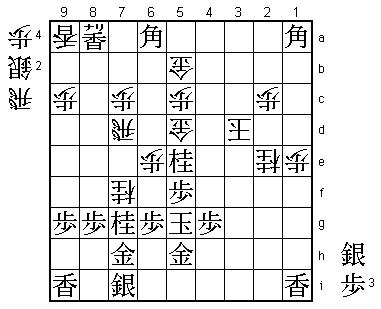 |
| Diagram 1 |
Looking for the Weak Point
In the position in Diagram 1, Nakahara has just played ...B*6a, closing in dangerously on my king. In
this situation, even when you are on the defensive, it is vital to find the weak point of Black's king
and defend in a way that exploits this weakness.
Even the most solid castle has a weak point. The Mino castle's weakness is the square diagonally
in front of the king on 7c. When attacking the Mino from the side, you need to get rid of the gold
on 6a. To break down the Yagura castle, it can be a good tactic to aim at the gold on 3b by dropping
a knight on 2d or a silver on 4a.
You must always be aware of the powers of your pieces in hand and know what pieces you need to launch
the most effective attack. In Diagram 1, the weak points of Black's king are its vulnerability to attack
by a bishop or a knight. If White had a knight, he could drop it on 4e. If he had a bishop, he would have
the powerful punches ...B*3i and ...B*8d. The essential requirement for White in this position, therefore,
is to find a way of getting a knight or bishop in hand.
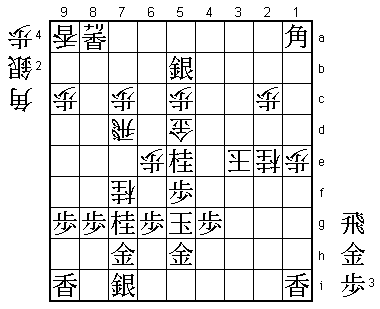 |
| Diagram A |
In Diagram 1, I dropped a rook in my own camp with ...R*5a. This aims to get a bishop in hand while taking
the offensive. What happens if Black now plays Bx5b+ Rx5b; S*4c K-3e; Sx5b= (Diagram A)? In this position,
the bishop-drop check ...B*3i is very powerful. After G*4h, White wins simply with ...S*3g, threatening mate
(...Sx4h=; Gx4h Bx4h+; Kx4h G*3g with forced mate). Since Black must part with his precious gold in hand with
G*4h after ...B*3i, he cannot go completely onto the offensive. In view of this threat, Black must attack while
keeping a silver in hand so he can answer ...B*3i with S*4h. Meijin Nakahara therefore played Bx5b+ Rx5b;
P*3f (Diagram 2), threatening mate while keeping his silver. This leads to a seesaw battle of attack and defense.
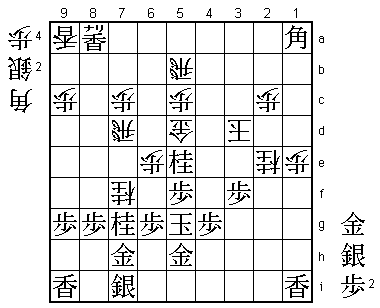 |
| Diagram 2 |
Defending While Attacking
In Diagram 2, I eliminated the mate threat with ...G-4e, whereupon Nakahara again threatened mate with G*4f (Diagram 3),
retaining his vital silver in hand. In Diagram 3, the threat is S*3e Gx3e; Gx3e mate. If White plays ...Gx4f here, it is
hard to find a defense after Px4f. In order to win in this position, I had to either mate Black's king or threaten mate
while eliminating Black's own mate threat. In Diagram 3, White has no forced mate, so I must find a way of eliminating
the mate threat. I can achieve this by making him use his silver in defense.
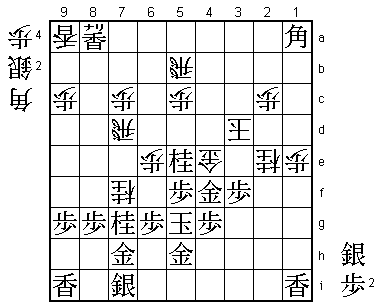 |
| Diagram 3 |
In Diagram 3, I played ...B*8d. Here Black would like to defend with P-6f, keeping his silver in hand, but this
leads to forced mate after ...Gx4f; Px4f Bx6f; K-6g Bx7g+ (Diagram B); Gx7g S*6f; Gx6f Px6f; Kx6f P*6e; K-5g S*6f;
K-4i G*3g; K-5i (Diagram C) G*6h; Gx6h Nx6h+; Sx6h N*6g; K-6i G*5i; Sx5i R-7i+; K-5h +Rx5i mate. This is quite a
long sequence, but it's almost entirely a straight line without many difficult variations.
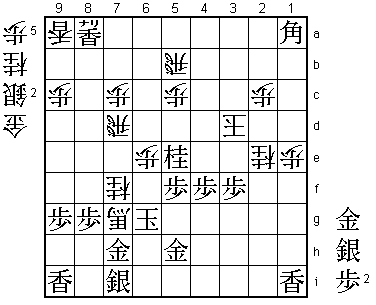 |
| Diagram B |
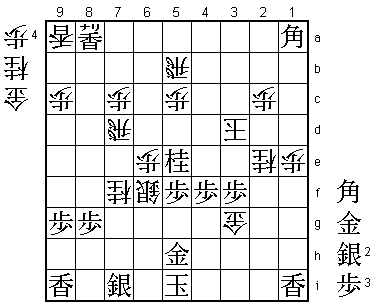 |
| Diagram C |
So we have seen that Black cannot defend and keep his silver with P-6f. This means that ...B*8d is not merely an
attacking move but also a defensive move that eliminates the mate threat to my own king by forcing Black to use his
silver to block the check.
In response to ...B*8d, Meijin Nakahara first played the tactic P*7e (to draw the bishop closer) and, after ...Bx7e, S*6f.
With this, the mate threat to my king disappeared. I had succeeded in making excellent use of the technique of
indirectly protecting my own king by attacking the opponent's king and forcing him to defend. This kind of
tactical sequence occurs quite often in the endgame.
After S*6f Px6f (Diagram 4), it is White who is threatening mate.
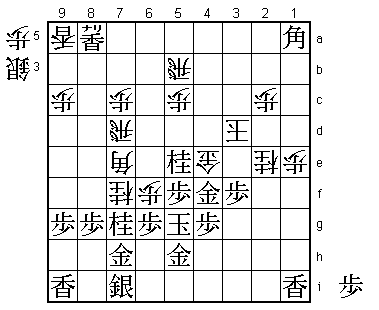 |
| Diagram 4 |
A Hallucination
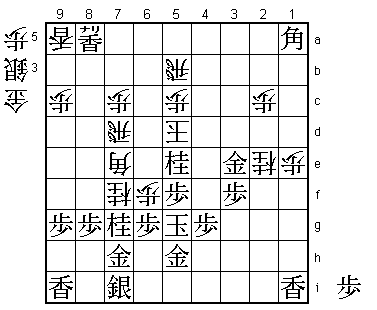 |
| Diagram 5 |
Nevertheless, the position in Diagram 4 is still unclear and quite unpredictable. The game continued Gx4e Kx4e; G*3e K-5d (Diagram 5).
Here I expected Black to first play B-4d+ K-6d (Diagram D) and then turn to defense with Px6f. In Diagram D, Black's king has more
space than in Diagram 5 because he now has an escape route from 4f to 4e. But Nakahara had a reason for not playing B-4d+. As we will
see, there was a variation which, though it did not occur in the game, would have made B-4d+ disadvantageous for Black.
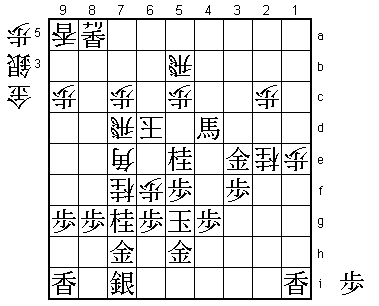 |
| Diagram D |
From Diagram 5, play continued Px6f R-4b; Gx2e S*3g (Diagram 6). Gx2e was a hallucination. With this move, Black planned to escape
via 4h while preparing the potential threat of N*4f. But in Diagram 6, the Black king’s escape route has been completely blocked and
the possibility of N*4f has also been eliminated. Why doesn't N*4f work in this position? In fact, Meijin Nakahara immediately
played N*4f here. Let us see what happened.
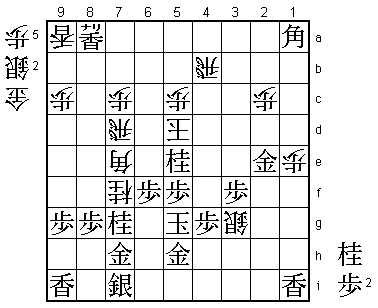 |
| Diagram 6 |
From Diagram 6, play proceeded N*4f Rx4f; Px4f Bx6f (Diagram 7); K-6g Nx6h+; G5hx6h (if (1) Kx6h S*5g; (2) G7hx6h G*7f; K-7h Gx7g; K-6i Gx6h;
(3) Kx6f G*7f; K-5g +Nx5h) G*7f; K-5h S-4h+ and Black resigned. In Diagram 7, if Black takes the bishop with Kx6f, there follows ...S*7e; K-5g
N*4e and mates. In Diagram 6 White had a forced mate after N*4f Rx4f; Px4f.
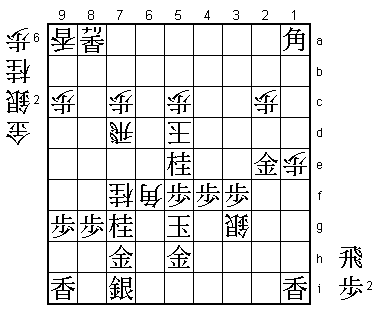 |
| Diagram 7 |
An Unclear Variation
Gx2e was a hallucination that overlooked ...S*3g. But instead of Gx2e, the variation G7h-6g (Diagram E) would have posed difficult problems.
The aim of G7h-6g, of course, is to take the key knight on 7f. If Black can remove this knight, his king will have more space and he will
also be threatening G-6e mate. G7h-6g is therefore a move with great potential.
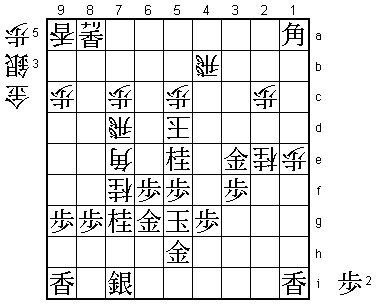 |
| Diagram E |
After G7h-6g, White must threaten mate before Black can get in Gx7f, but this does not look possible in Diagram E. But if there is no
way of threatening mate and no way of defending against Gx7f, is this a losing position for White?
It is time to remember the words at the beginning of this chapter: "When the kings are near each other in the middle of the board,
checking is not just chasing." In such cases, checking is an effective method of changing the situation of the two kings, and in
Diagram E the silver drop ...S*6i is the only way of escaping from this tight spot. After ...S*6i; Gx7f Bx6f; Kx6f (if Gx6f Rx7g+)
Rx7f (Diagram F) Kx7f S*7e; Kx7e P-7d; Kx7d G*6d; K-8e G*7d (Diagram G); K-7f (if K-9f S*9e; Kx9e P-9d) G7d-7e; K-6g P*6f; K-5g Sx5h+;
Kx5h P-6g+; Px6g Rx4g+; K-7h G-6g; K-8i (Diagram H), chasing the Black king around the board. The aim of this series of checks is not to
mate but to remove the knight on 7g which prevents White's king from moving forward. After ...Gx7g, Black is no longer threatening
mate. By means of successive checks, White thus succeeds in changing the mutual relationship of the kings.
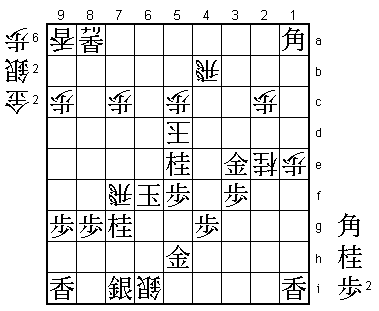 |
| Diagram F |
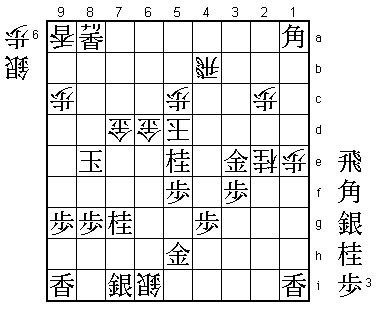 |
| Diagram G |
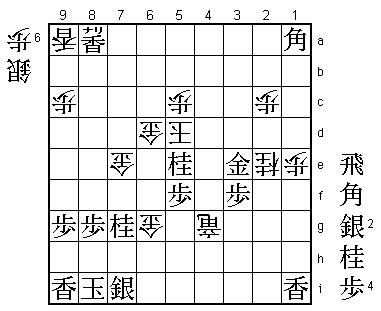 |
| Diagram H |
Even so, the position after ...Gx7g is still unclear since Black can resist by removing White's promoted rook with R*4d +Rx4d; Bx4d+ (Diagram I).
It is difficult to say which side is winning here. Nevertheless, I think you can now understand that, by means of a series of checks, White has
succeeded in extricating himself from what seemed like a hopeless situation after G7h-6g.
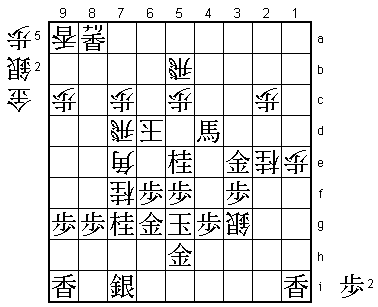 |
| Diagram I |
Just One Check
 |
| Diagram D |
Earlier in this chapter, I mentioned that I would explain later why Meijin Nakahara chose not to insert the check B-4d+ K-6d (Diagram D) before
playing Px6f. This was because it would have had a significant effect on the variations following G7h-6g. After B-4d+ K-6d; Px6f S*3g; G7h-6g (Diagram J),
if play continues along similar lines as before, i.e. ...S*6i; Gx7f Bx6f; Kx6f Rx7f; Kx7f, the fact that White's king has moved from 5d to 6d enables
him to play ...G*7e immediately. In the previous variation with the king on 5d, White had to take trouble to create a foothold for the attack, but
with his king on 6d he can corner Black's king with relative ease. This shows that Meijin Nakahara thought deeply about the variations after G7h-6g
and decided not to insert B-4d+ K-6d. In the endgame, just one check (B-4d+) can subtly change the situation.
 |
| Diagram I |
The most important thing in the endgame is to play according to clear requirements. You must know when you have to threaten mate and when
you have to deliver mate. The opening and middlegame are more difficult because the requirements are not so clear and vary greatly according
to concepts or individual preferences regarding, for instance, winning material or making the king safer.
An essential skill in mastering the endgame is first to set clear requirements in the given position. Once you have done this, the
lines you consider will become much simpler because not many moves meet the requirements. In most cases, you can narrow it down to
two or three moves and then thoroughly analyze the variations. The method of successive checks to eliminate the mate threat to my
king in the position after G7h-6g (Diagram E) is a case in point. It proves that proverbs such as "checking is just chasing" lose
their meaning under the particular conditions of the endgame. This example shows how checking can be wonderfully effective when
the kings are close to each other. In each case, you must clearly grasp the situation and set the requirements. You cannot rely
on proverbs or even common practice in the endgame.


















